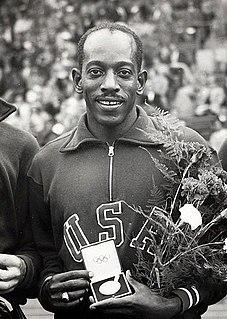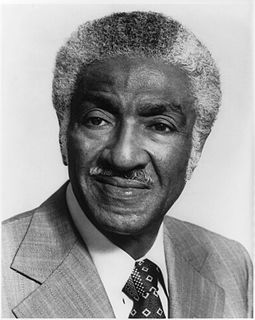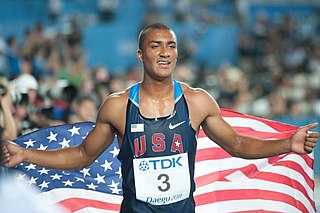Related Research Articles

William Harrison "Bones" Dillard was an American track and field athlete, who is the only male in the history of the Olympic Games to win gold in both the 100 meter (sprints) and the 110 meter hurdles, making him the “World’s Fastest Man” in 1948 and the “World’s Fastest Hurdler” in 1952.
Andrew William Stanfield was an American sprinter and Olympic gold and silver medallist.

Ralph Harold Metcalfe Sr. was an American track and field sprinter and politician. He jointly held the world record in the 100-meter dash and placed second in that event in two Olympics, first to Eddie Tolan in 1932 at Los Angeles and then to Jesse Owens at the 1936 Olympics in Berlin, Germany. Metcalfe won four Olympic medals and was regarded as the world's fastest human in 1934 and 1935. He later went into politics in the city of Chicago and served in the United States Congress for four terms in the 1970s as a Democrat from Illinois.

Martin Irving Glickman was an American radio announcer who was famous for his broadcasts of the New York Knicks basketball games and the football games of the New York Giants and the New York Jets.
David Donald Albritton was an American athlete. He had a long career that spanned three decades and numerous titles and was one of the first high jumpers to use the straddle technique. He was born in Danville, Alabama.

The United States competed at the 1936 Summer Olympics in Berlin, Germany. The Americans finished second in the medal table behind the hosts. 359 competitors, 313 men and 46 women, took part in 127 events in 21 sports.

Dean Bartlett Cromwell, nicknamed "Maker of Champions", was an American athletic coach in multiple sports, principally at the University of Southern California (USC). He was the head coach of the USC track team from 1909 to 1948, excepting 1914 and 1915, and guided the team to 12 NCAA team national championships and 34 individual NCAA titles. He was the head coach for the U.S. track team at the 1948 Olympic Games in London, and assistant head coach for the U.S. track team at the 1936 Berlin Olympics.
Sam Stoller was an American athlete who specialized in sprinting and long jumping. He tied the world record in the 60-yard dash in 1936. Stoller is best known for his exclusion from the American 4 × 100 relay team at the 1936 Summer Olympics in Berlin. The 2-man substitution triggered widespread speculation that he and Marty Glickman—the only two Jews on the U.S. track team—were excluded because U.S. Olympic Committee chairman Avery Brundage wanted to avoid embarrassing Adolf Hitler by having two Jewish athletes win gold medals. Stoller vowed at the time that he would never run again, but he returned in 1937 to win both the Big Ten Conference and NCAA championships in the 100-yard dash. After graduating from the University of Michigan in 1937, Stoller briefly went into a singing and acting career as "Singin' Sammy Stoller."

John Kenneth Doherty was an American decathlon champion, college track and field coach, author and longtime director of the Penn Relays. While a student at the University of Michigan, Doherty won the American decathlon championship in 1928 and 1929 and won the bronze medal in the event at the 1928 Summer Olympics in Amsterdam. He later served as a track coach at Princeton University (1929–1930), the University of Michigan (1930–1948), and the University of Pennsylvania (1948–1957). He was also the meet director for the Penn Relays from 1956 to 1969 and of the first dual track meet between the United States and the Soviet Union in 1959. He was also a published author of works on track coaching, and his Track & Field Omnibook was regarded as "the track coach's bible" from the 1970s through the 1990s. Doherty has been inducted into at least six athletic halls of fame, including the National Track and Field Hall of Fame and athletic halls of fame at the University of Pennsylvania, University of Michigan, and Wayne State University.

Ashton James Eaton is a retired American decathlete and two-time Olympic champion, who holds the world record in the indoor heptathlon event. Eaton was the second decathlete to break the 9,000-point barrier in the decathlon, with 9,039 points, a score he bettered on August 29, 2015, when he beat his own world record with a score of 9,045 points, and remains the only person to exceed 9000 points twice. His world record was broken by Frenchman Kevin Mayer on September 16, 2018 with a total of 9,126 points, who became the third man to pass the 9,000-point barrier.

The Michigan Wolverines men's track and field team is the intercollegiate track and field program representing the University of Michigan. The school competes in the Big Ten Conference in Division I of the National Collegiate Athletic Association (NCAA).
The men's 4 × 100 metres relay event at the 1936 Olympic Games took place on August 9. The United States team of Jesse Owens, Ralph Metcalfe, Foy Draper and Frank Wykoff won in a world record time of 39.8.
Walter George Marty was an American high jumper. He set both indoor and outdoor world records in his speciality and was national co-champion both indoors and outdoors in his peak year of 1934.
The 1932 United States Olympic trials for track and field were held on July 15 and July 16, 1932 and decided the United States team for the 1932 Summer Olympics in Los Angeles. The trials for men and women were held separately; men competed in Stanford Stadium in Stanford, California, while women competed in Dyche Stadium in Evanston, Illinois. Both meetings also served as the annual United States outdoor track and field championships. For the first time, only the top three athletes in each event qualified for the Olympics; until 1928, every nation had been allowed four entrants per event.
The 1928 United States Olympic trials for track and field were held between July 3 and July 7, 1928 and decided the United States team for the 1928 Summer Olympics in Amsterdam. For the first time, women's track and field was part of the Olympic program. The trials for men and women were held separately; men competed at Harvard Stadium in Cambridge, Massachusetts on July 6 and July 7, while women competed at City Field in Newark, New Jersey on July 4. Three of the men's events were contested in Philadelphia, Pennsylvania between July 3 and July 5.
Charles Beetham was an American middle-distance runner. He was United States champion in the 800-meter run in 1936, 1939, 1940 and 1941 and NCAA champion in 1936; he entered the 1936 United States Olympic Trials as one of the favorites, but fell in the final and failed to qualify for the Olympics.
Harold William Manning was an American long-distance runner. He held the American record in the men's 3000-meter steeplechase from 1934 to 1952 and briefly held the world best in 1936. He represented the United States in the steeplechase at the 1936 Summer Olympics, placing fifth.
Glen Wilson Dawson was an American runner. He represented the United States in the men's 3000-meter steeplechase at the 1932 and 1936 Summer Olympics, qualifying for the final both times.

Rolland Lee Romero was an American triple jumper. He was national champion in 1935 and competed in the 1932 and 1936 Summer Olympics.

Anne Marie Vrana O'Brien was an American sprinter. She represented the United States at the 1928 Summer Olympics in the 100 meters and at the 1936 Summer Olympics in the 80-meter hurdles. In 1932 she equaled the 80-meter hurdles world record, but fell at the Olympic Trials and missed the Olympics.
References
- 1 2 3 4 5 6 7 8 9 10 11 12 13 14 15 16 17 18 19 20 21 22 23 24 25 26 27 28 29 30 31 32 33 34 35 36 37 38 39 Hymans, Richard (2008). "The History of the United States Olympic Trials – Track & Field" (PDF). USA Track & Field . Retrieved October 20, 2015.
- ↑ Currie, George (July 11, 1936). "On to the Olympics!" (PDF). Brooklyn Daily Eagle . Retrieved November 5, 2015.
- ↑ "Heat Unbroken, Threatens New Records Today" (PDF). Brooklyn Daily Eagle. July 12, 1936. Retrieved November 5, 2015.
- 1 2 3 4 5 "Albritton and Johnson Jump 6 Ft. 9 3–4 In. at Olympic Trials". Chicago Tribune . July 13, 1936. Retrieved November 5, 2015.
- 1 2 3 Currie, George (July 12, 1936). "Owens Shines In Olympic Tryouts" (PDF). Brooklyn Daily Eagle. Retrieved November 5, 2015.
- 1 2 3 4 5 6 7 8 9 Hymans, Richard; Matrahazi, Imre. "IAAF World Records Progression" (pdf) (2015 ed.). International Association of Athletics Federations . Retrieved October 20, 2015.
- ↑ Berkow, Ira (August 30, 1990). "The man who told Hitler no". Wilmington Morning Star . Retrieved November 5, 2015.
- 1 2 3 "Lenore, Pitt Star Triumph". The Pittsburgh Press . July 13, 1936. pp. 21–22. Retrieved November 6, 2015.
- 1 2 3 4 Currie, George (July 13, 1936). "Owens Leading The Parade as Strongest Threat" (PDF). pp. 6–7. Retrieved November 6, 2015.
- 1 2 "Lenore Kight Wingard and Stoller to Make Trip". The Cincinnati Enquirer . July 13, 1936. Retrieved November 5, 2015.
- 1 2 "Metcalfe Finishes Fifth in 200 Meters of Final Olympic Trials". Milwaukee Journal . July 13, 1936. Retrieved November 6, 2015.
- 1 2 3 Abrahamson, Alan (January 5, 2001). "Shame of the Games". Los Angeles Times . Retrieved November 5, 2015.
- ↑ "Olympic Body Changes Two Race Results". Salt Lake Tribune . July 13, 1936. Retrieved November 6, 2015.
- ↑ "United States Athletics at the 1936 Berlin Summer Games". Sports Reference LLC. Archived from the original on April 17, 2020. Retrieved November 6, 2015.
- ↑ Jukola, Martti (1935). Huippu-urheilun historia (in Finnish). Werner Söderström Osakeyhtiö.
- ↑ "Berks Runner Third In 1,500-Meter Finals". Reading Eagle . July 13, 1936. Retrieved November 9, 2015.
- ↑ Gould, Alan (Associated Press) (July 17, 1936). "Yanks, World's Best In Discus, Bow To Europe's Javelineers". Ellensburg Daily Record . Retrieved November 7, 2015.
- ↑ Gould, Alan (Associated Press) (July 3, 1936). "Well-Balanced American Squads Monopolize Olympic Team Honors". Kingston Daily Freeman . Retrieved November 7, 2015.
- ↑ "Glenn Morris Bio, Stats and Results". Sports Reference LLC. Archived from the original on April 17, 2020. Retrieved November 7, 2015.
- 1 2 "Morris Seen Greatest Ace In Decathlon". Prescott Evening Courier . July 3, 1936. Retrieved November 7, 2015.
- 1 2 Ward, Michael (2006). Ellison "Tarzan" Brown: The Narragansett Indian Who Twice Won the Boston Marathon . McFarland. ISBN 9780786424160.
- 1 2 "Bill McMahon Is In Front In National Marathon Race". The Cincinnati Enquirer . May 31, 1936. Retrieved October 31, 2015.
- ↑ "West Coast Leads In Olympic Hopes". Lawrence Journal-World . March 25, 1936. Retrieved November 7, 2015.
- ↑ ""Stroll" Won By Detroit Man". Cincinnati Enquirer. May 25, 1936. Retrieved November 7, 2015.
- ↑ "Olympic Track Tryouts For Yank Girls Scheduled Today". Montana Standard . July 4, 1936. Retrieved November 7, 2015.
- 1 2 3 4 5 "Helen Stephens Smashes World 100 Meter Mark". Chicago Tribune. July 5, 1936. Retrieved November 7, 2015.
- 1 2 3 4 "Helen Stephens Cracks Stella Walsh's Record". The Milwaukee Journal. July 5, 1936. Retrieved November 7, 2015.
- ↑ "Tidye Pickett Bio, Stats and Results". Sports Reference LLC. Archived from the original on April 18, 2020. Retrieved November 7, 2015.
